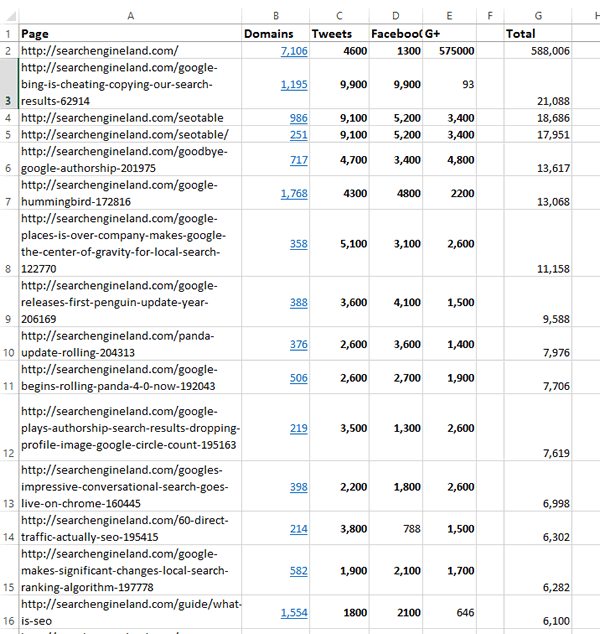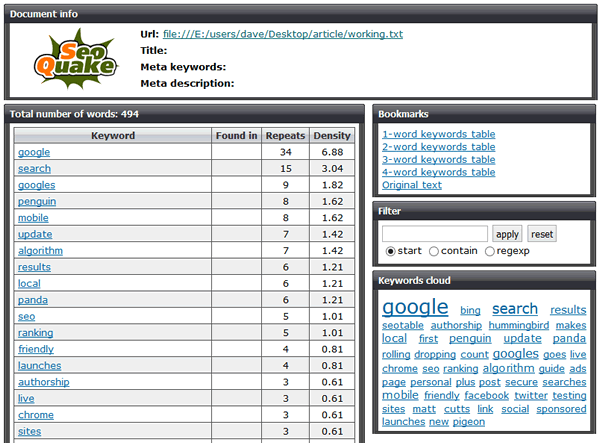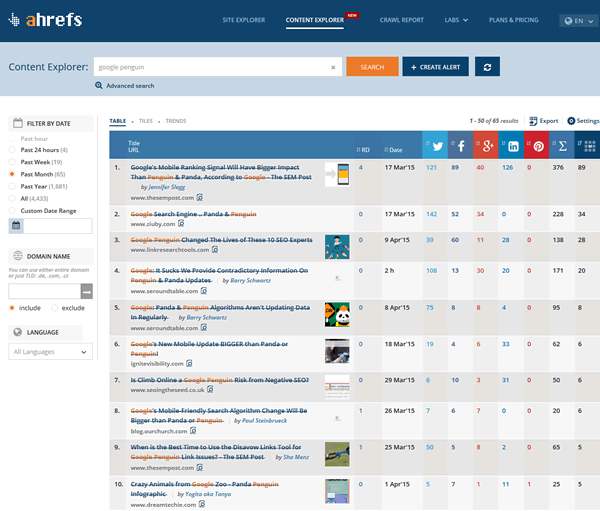Content Inspiration From Competitors
What’s a simple way to look at which content is driving the most links and social signals for your competitors?
What’s a simple way to look at which content is driving the most links and social signals for your competitors?
Earlier this week Jayson DeMers wrote an article here on Search Engine Watch titled, “5 Ways to Use Your Competitors to Gain SEO Momentum.” While reading it I thought of how each area could be expanded into its own article getting into a bit more detail on what tools to use. Unfortunately my favorite area to take inspiration from competitors is in the area of link-building and I’d already written pieces on two of my favorite tools for that which were:
• Hub Link Building With Majestic, and
So stretching my brain further I moved to the second area Jayson wrote about: content. In his article he points out that you can look to which content your competitors are having the greatest success with and be inspired by that knowledge. So that will be the focus of this piece…what’s a simple way to look at which content is driving the most links and social signals for your competitors. (Note: this is not to say copy them…it’s to say understand what they’re doing successfully and create the same formula for yourself.)
For this task there are a few different ways you can pull your data but I’m going to focus on the one tool that does it best on its own to insure that the strategy is affordable to virtually anyone. The perk to the tool I’m going to be referencing is one they’ve just launched as a new feature that uses competitor information from folks you might not know are competitors. And so let’s begin with …
So let’s start by expanding on Jayson’s point, that you can use a competitor to be inspired in the content you’ll want to create. That is, the content that’ll attract links and social traffic. To this end we’re going to use as our example a site competing in the SEO journalism space.
Let’s go through the steps together…
You begin by entering the site you want to be inspired by.

The next step is to get a list of the top linked-to and referenced pages. It’s as easy as the click of a button. Specifically…this one:

Now it’s time to view the data. You can see from the circle on the left that you can switch between a focus on social signals and backlinks and on the right you can export this data. You can feel free to work directly off this screen or carry on (as I usually do) to step four.

I personally find that this type of data is easier to work with in spreadsheet format. If you export it you’ll get a breakdown of the link metrics which may well be good enough and easy to work with. If this is what you’re after feel free to skip to the next step however if you’re also interested in social metrics the job is a bit more manual (a bit…not a lot).
Click the settings button right above the table and choose to show 100 rows. You then have the simple task of copying the data into spreadsheets. If you want more than 100 rows obviously click to the next page and do the same until you have enough data for your needs. At his stage I like to remove the data I’m not using. For our purposes here I’ll reduce the columns to:
Assuming the first row is headers you can use the following formula in Excel to total the number of linking domains and shared into Column G. You’ll do this for row 2.
Formula: =SUM(B2:F2)
Select the bottom right of the cell with the totaled data and drag down to include all the rows you have included to give you the total shares and linking domains for each page. You can then sort it by column G to order by the most total references which would look like:

For many this is good enough. You can either visit the pages to see what’s at them or simply scan through the URLs if they include the title as this example does and get a good feel for what’s being shared most. I occasionally like to take it one step further.
This step isn’t too tricky and will give you a really good feel for the top focus points being shared and linked to. It requires that the site uses the titles in the URL.
Select the pages (Column A) for all the terms with a solid number of shares. In this case I’ll use the first 55 rows which is everything with a total number of shares and linking domains over 2,500. Copy this list into a notepad document and do a couple find and replaces.
First – remove the domain
Second – replace all / and – with blank spaces
This will leave you with a list of all the paths and page names. Occasionally I like to remove paths as well. If that’s the case just adjust the find-and-replace above to change/to, and save the notepad as a csv and reopen in Excel. This will separate the paths into different columns though can be tedious if the structure is varied (i.e. not all the pages are at the same path-level).
From there you simply need to save the document and reopen it in Firefox (or Chrome). Using the free add-on SEO Quake you can now run the keyword densities on the page and get a screen like:

This screen nicely breaks down the most common terms found in the shared pages into 1, 2, and 3 word sets. This can give you a very quick snapshot of the main subjects you should be writing toward. Of course you’ll want to look back at earlier steps to see specifically what topics got shared the most but this will help you lock in on the general trends, especially when you’re dealing with very large lists.
I mentioned above that Ahrefs has also added a new feature to help isolate what topics were getting some great traction in your niche. The tool they launched is included in their packages and is called Content Explorer as is fast becoming one of my favorite features.
If I enter into the topic request “google penguin” (having learned in Step Five above that that’s a good subject) and select a timeframe of the past month I get presented with a page like:

This shows me a bunch of the top shared content from the Web related to my query over the timeframe selected. If I’m really interested I can specify domains or TLDs and set alerts. A very handy new feature from this toolset.
Competitor backlink research is a great place to start but it’s also important to remember that focusing only on this area will insure that you’re always just one step behind them. That said, making sure to do what they’re doing best and then add some strategies of your own will insure a strong profile built for success. But finding those opportunities are the subject of another article.